#tungusic people
Explore tagged Tumblr posts
Text
Regular reminder that "Celtic shamanism" doesn't exist. It never did.
Whatever the Celts were doing, it wasn't "shamanism" and it'll never be.
Shamans are Tungusic. End of story.
#witches of color#witchblr#paganblr#cultural appropriation#closed practices#shamanism#tungusic people#misinformation
111 notes
·
View notes
Text

Tungusic people from Russia
Russian vintage postcard, mailed in 1901 to Lyon, France
#sepia#tungusic#photography#historic#lyon#vintage#france#mailed#postkaart#russia#ansichtskarte#ephemera#russian#carte postale#postcard#postal#briefkaart#people#photo#tarjeta#1901#postkarte
8 notes
·
View notes
Text
#genomes#sinitic people#neolithic yellow river farmers#han chinese 90-95%#korean#20 % amur river hunters#tungusic and mogolic ancestors#japanese 20% dna amur river hunters#20 % jomon hunter/gather ancestry
0 notes
Text
youtube
1 note
·
View note
Note
seeing a glimpse of izutsumi's mom's appearance, really made me wish the story delves in more of izutsumi's unknown past. like are her parents still alive? and how exactly izutsumi became a beast man? who made her like that?
The story keeps focus on whats happening at the moment and there isn't many flashbacks, I think we don't know because Izutsumi doesn't know or remember.
By context it was probably some scumbag demi human seller that turned her into beastkin to sell her to a freakshow. How he got his hands on a human child we can only guess. She was turned when her human half was 6 and it says she was separated from her parents.
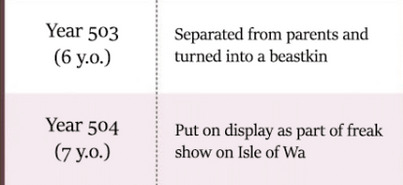
By that little description I don't think they sold her so perhaps she was kidnapped?
She wasn't originally from the Isle of Wa (the equivalent of japan in dunmeshi from what I understand) either. So she was taken from one of the other islands.
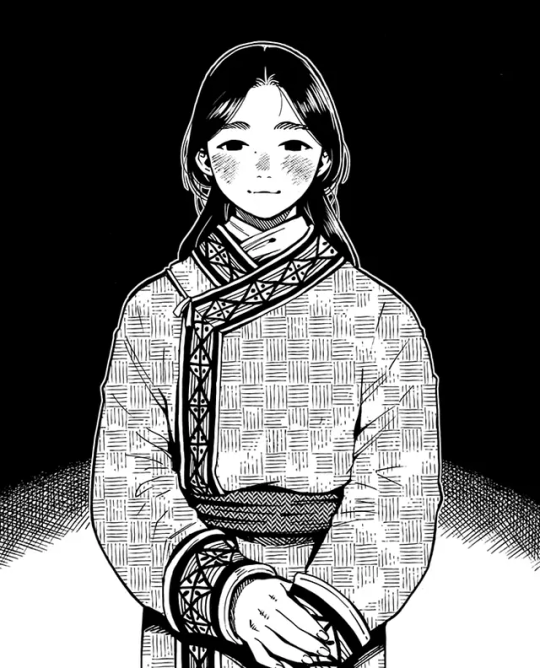
The wiki says her mother is wearing a Deel
Here's what wikipedia says "A deel (Mongolian: ᠳᠡᠪᠡᠯ /дээл [deːɮ]; Buryat: дэгэл [dɛɡɛɮ]) is an item of traditional clothing commonly worn by Mongols and Turkic and Tungusic peoples for centuries, and can be made from cotton, silk, wool, or brocade."
So yeah Izutsumi is a victim of human trafficking that was turned into a beastman to make money for her kidnappers.
434 notes
·
View notes
Text



Amanita Muscaria 🍄🌀🍄 Talon Abraxas
The Fly Agaric mushroom (Amanita muscaria) has a long history in the shamanic traditions of Siberian, Tungusic, and Samoyedic cultures. This mushroom was not just used for its hallucinogenic properties but also as a spiritual conduit for accessing the unseen layers of reality.
Unlike typical psychedelic mushrooms, the Fly Agaric does not contain psilocybin but instead active compounds ibotenic acid and muscimol. These compounds interact with the body differently than those of traditional shrooms, yet they can still lead to altered states of consciousness and hallucinations. These altered states were essential for Siberian shamans, who used them to engage with the spirit world. The consumption of this mushroom was typically preceded by various ritualistic preparations such as fasting, isolation, and the wearing of ceremonial garments, believed to purify the shaman and enhance the mushroom’s spiritual effects. These mushrooms also have cultural significance, as they are woven into the folklore and traditions of these communities. For example, the Tungsic and Samoyed people hold the mushroom in high esteem and have folklore and mythologies rich with references to mushrooms. These cultures believed that mushrooms, especially the Fly Agaric, could act as mediators between the natural world and the spiritual realm, providing them with the ability to understand hidden wisdom, communicate with ancestral spirits, interpret dreams, and even see into the future. --The Spiritual Significance of Mushrooms in Ancient and Modern Cultures
82 notes
·
View notes
Text
Fishskin Robes of the Ethnic Tungusic People of China and Russia
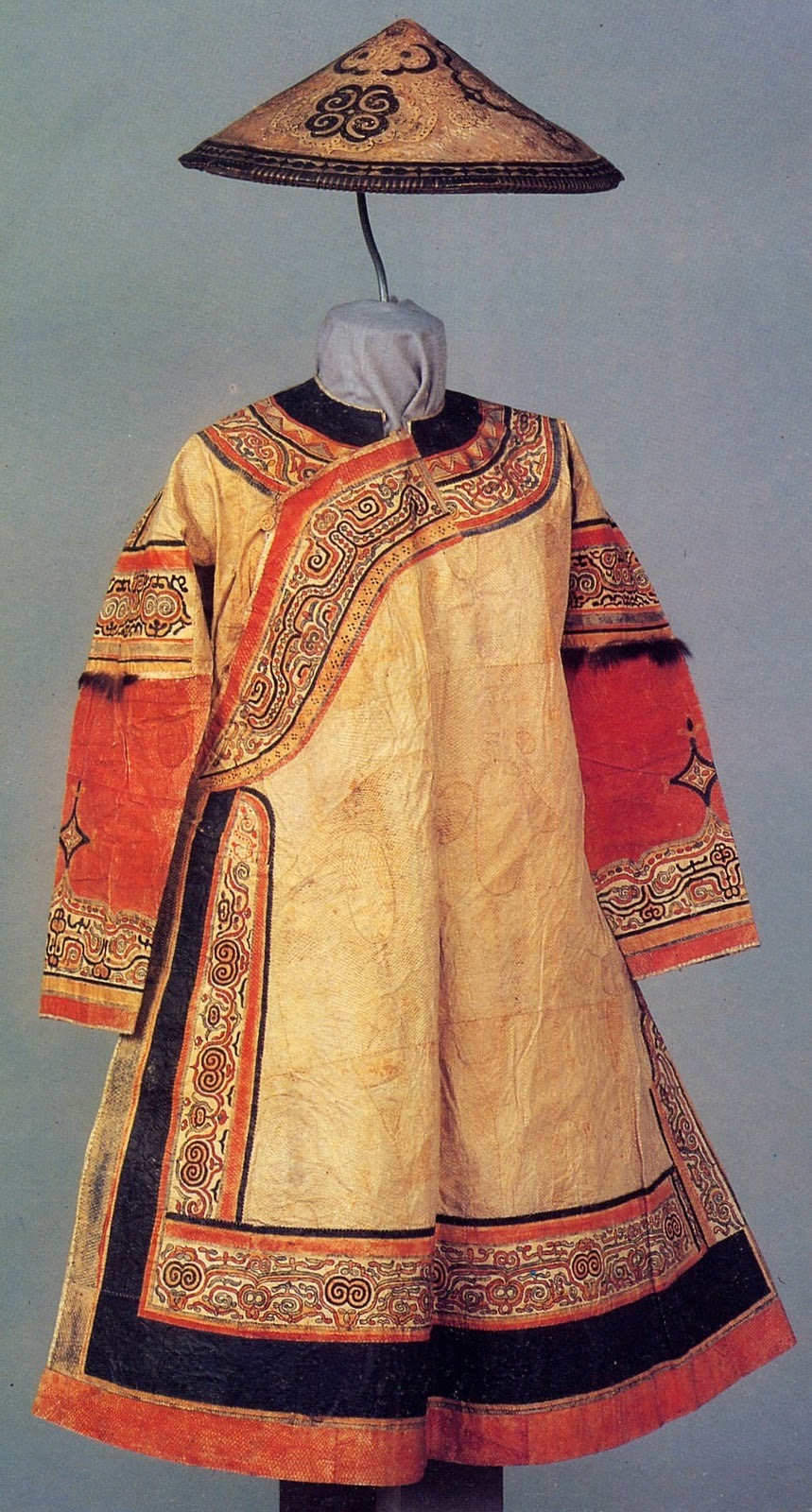
Oroch woman’s festive robe made of fish skin, leather, and decorative fur trimmings [image source].
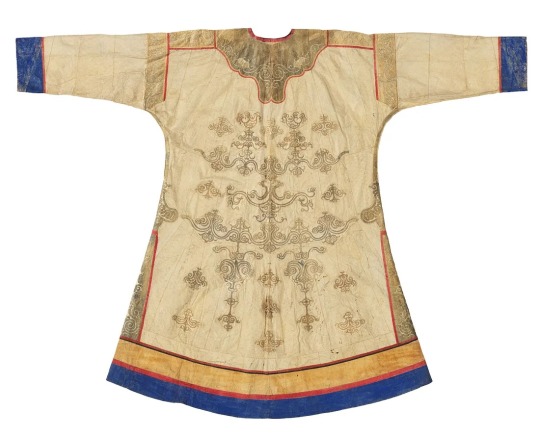
Nivkh woman’s fish-skin festival coats (hukht), late 19th century. Cloth: fish skin, sinew (reindeer), cotton thread; appliqué and embroidery. Promised gift of Thomas Murray L2019.66.2, Minneapolis Institute of Art, Minnesota, United States [image source].
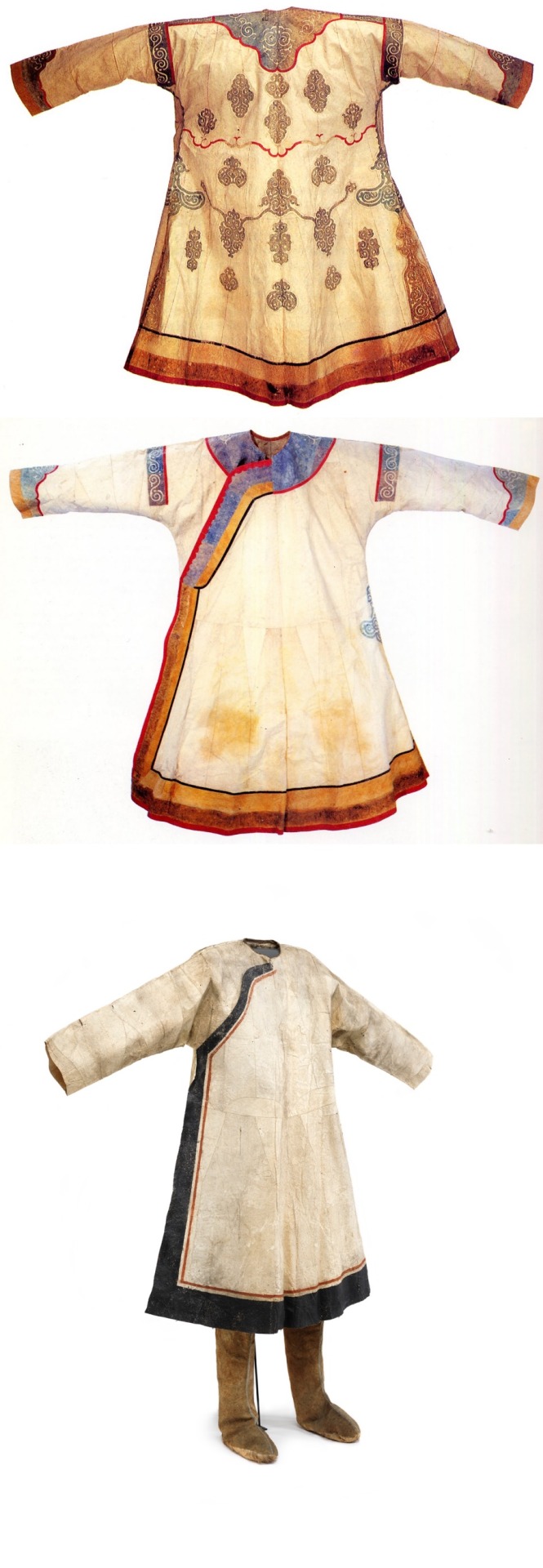
Back view of a Nivkh woman’s robe [image source].
Front view of a Nivkh woman’s robe [image source].
Women’s clothing, collected from a Nivkh community in 1871, now in the National Museum of Denmark. Photo by Roberto Fortuna, courtesy Wikimedia Commons [image source].
The Hezhe people 赫哲族 (also known as Nanai 那乃) are one of the smallest recognized minority groups in China composed of around five thousand members. Most live in the Amur Basin, more specifically, around the Heilong 黑龙, Songhua 松花, and Wusuli 乌苏里 rivers. Their wet environment and diet, composed of almost exclusively fish, led them to develop impermeable clothing made out of fish skin. Since they are part of the Tungusic family, their clothing bears resemblance to that of other Tungusic people, including the Jurchen and Manchu.
They were nearly wiped out during the Imperial Japanese invasion of China but, slowly, their numbers have begun to recover. Due to mixing with other ethnic groups who introduced the Hezhen to cloth, the tradition of fish skin clothing is endangered but there are attempts of preserving this heritage.
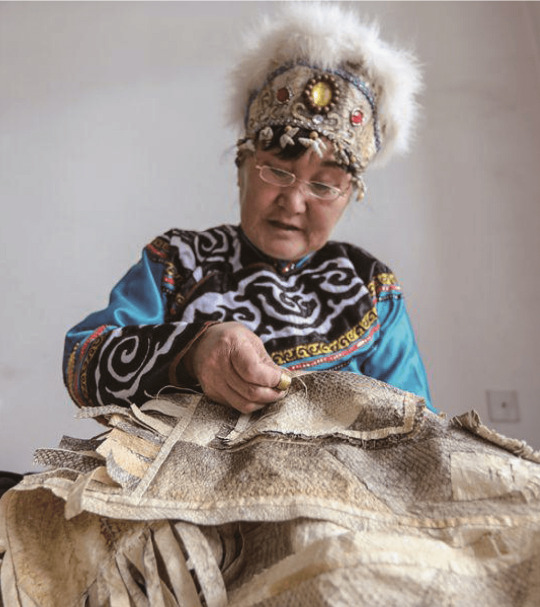
Hezhen woman stitching together fish skins [image source].


Top to bottom left: You Wenfeng, 68, an ethnic Hezhen woman, poses with her fishskin clothes at her studio in Tongjiang, Heilongjiang province, China December 31, 2019. Picture taken December 31, 2019 by Aly Song for Reuters [image source].
Hezhen Fish skin craft workshop with Mrs. You Wen Fen in Tongjian, China. © Elisa Palomino and Joseph Boon [image source].
Hezhen woman showcasing her fishskin outfit [image source].
Hezhen fish skin jacket and pants, Hielongiang, China, mid 20th century. In the latter part of the 20th century only one or two families could still produce clothing like this made of joined pieces of fish skin, which makes even the later pieces extremely rare [image source].
Detail view of the stitching and material of a Hezhen fishskin jacket in the shape of a 大襟衣 dajinyi or dajin, contemporary. Ethnic Costume Museum of Beijing, China [image source].
Hezhen fishskin boots, contemporary. Ethnic Costume Museum of Beijing, China [image source].
Although Hezhen clothing is characterized by its practicality and ease of movement, it does not mean it’s devoid of complexity. Below are two examples of ornate female Hezhen fishskin robes. Although they may look like leather or cloth at first sight, they’re fully made of different fish skins stitched together. It shows an impressive technical command of the medium.
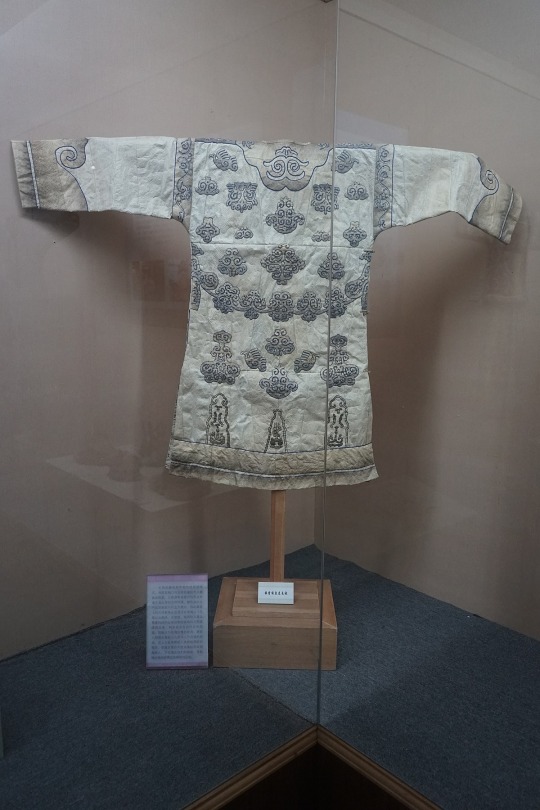
赫哲族鱼皮长袍 [Hezhen fishskin robe]. Taken July 13, 2017. © Huanokinhejo / Wikimedia Commons, CC BY 4.0 [image source].
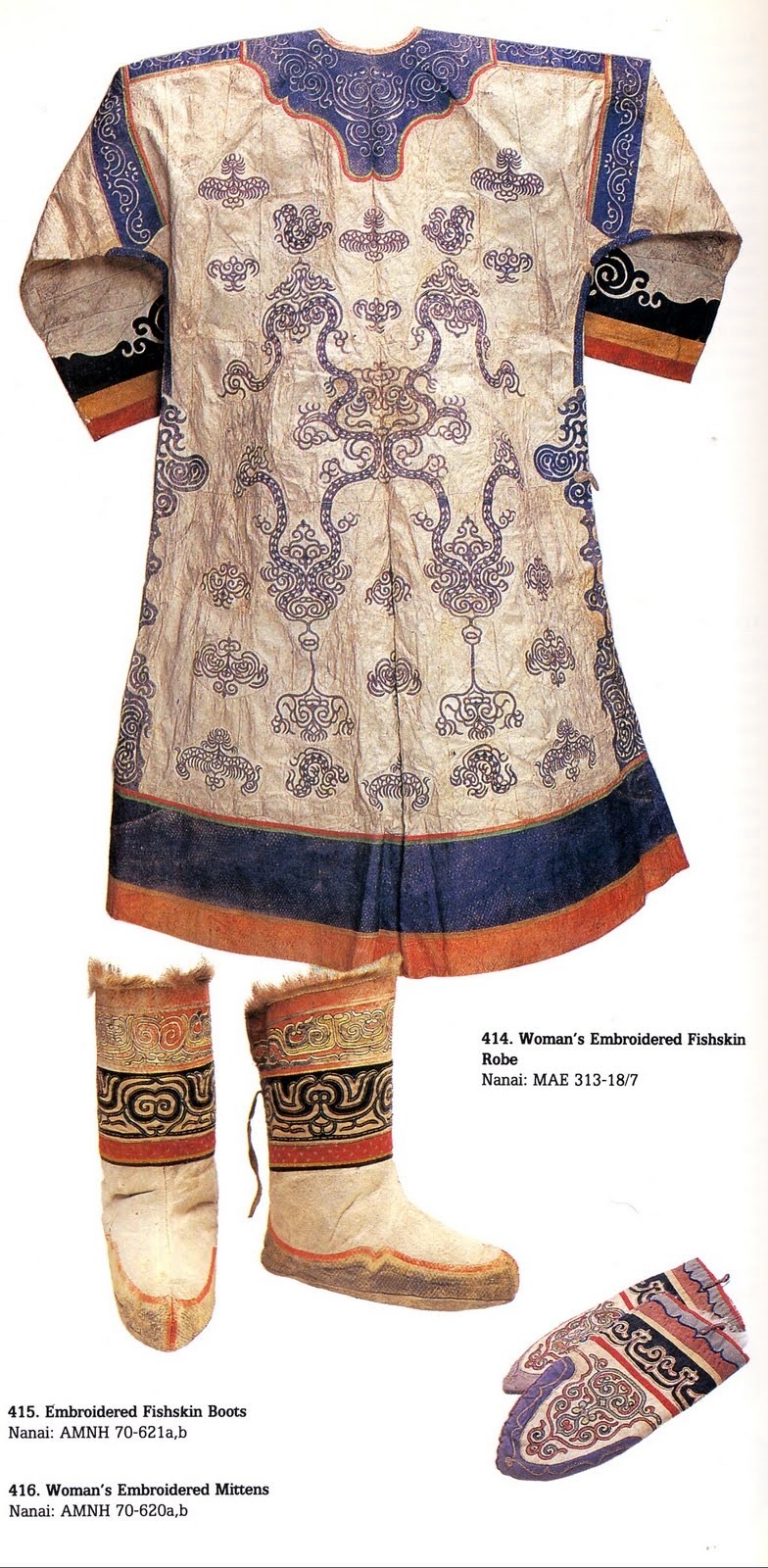
Image containing a set of Hezhen clothes including a woman’s fishskin robe [image source].
The Nivkh people of China and Russia also make clothing out of fish skin. Like the Hezhen, they also live in the Amur Basin but they are more concentrated on and nearby to Sakhalin Island in East Siberia.


Top to bottom left: Woman’s fish-skin festival coat (hukht) with detail views. Unknown Nivkh makers, late 19th century. Cloth: fish skin, sinew (reindeer), cotton thread; appliqué and embroidery. The John R. Van Derlip Fund and the Mary Griggs Burke Endowment Fund; purchase from the Thomas Murray Collection 2019.20.31 [image source].
Top to bottom right: detail view of the lower hem of the robe to the left after cleaning [image source].
Nivkh or Nanai fish skin boots from the collection of Musée du quai Branly -Jacques Chirac. © Marie-Lan Nguyen / Wikimedia Commons, CC BY 4.0 [image source].
Detail view of the patterns at the back of a Hezhen robe [image source].
Read more:
#china#russia#tungusic#hezhe#nanai#fishskin#ethnic minorities#nivkh#chinese culture#history#russian culture#amur basin#heilongjiang#east siberia#ethnic clothing
995 notes
·
View notes
Text
The Many Lives of Mongolian Shamanism

The following is excerpted from Sky Shamans of Mongolia: Meetings with Remarkable Healers by Kevin Turner.
For thousands of years, Mongolia has been a nexus of Eurasian shamanisms that competed, mixed, and meshed across our planet's largest continent. Shamanism appears to have emerged with the very dawn of human consciousness, but archeologists can probably speak with confidence about only the past 30,000 to 70,000 years.
Archeological discoveries in Eurasia alone indicate that the practice of shamanism reaches back at least to 35,000 BCE, easily making shamanism the oldest spiritual practice known to mankind. Modern religious faiths such as Buddhism and Christianity are toddlers in comparison, and psychology is a mere newborn.
The word shaman originated from the Tungusic tribal language groups (from areas to the north and east of Mongolia), which are related to Mongolic languages. These are both part of the broader Altaic language group, which includes Turkic, Manchurian, and scores of other Inner Asian and Siberian languages, and may include Korean and Japanese at the easternmost reach. The modern term "shaman" has now been adopted by many as a catch-all word to describe those who by spiritual means seek direct access to information and healing power not ordinarily available.
The nomadic northern Siberian shamanic traditions tend to retain the highly individualistic aspects of shamanism; by contrast, a most interesting facet of Mongolian and Inner Asian shamanism is the amalgamation of the shamans' direct experiences of other realities with a religious belief system known as Tengerism (Heaven or Sky God-ism). Tengerism originated in Sumeria, one of humanity's earliest civilizations, and probably derived from the early experiences of the shamans, prophets, and mystics of pre-Mesopotamian eras.
The modern Mongolian term Tenger (or Tengri), meaning both "sky realms" and "sky spirits," almost certainly derives from the Sumerian word Dingir, also meaning both "sky realm(s)" and "deity(-ies)." The concept of divinity in Sumerian was closely associated with the heavens, evident from the shared cuneiform sign for both heaven and sky, and from the fact that its earliest form is a star shape. The name of every deity in Sumerian is prefixed by a star symbol.
Mircea Eliade proposed that Tengrism may be the closest thing we have found to a reconstructed proto-Indo-European religion. It is also evident that Tengrism's three-layered worldview is nearly identical to the tripartite world found in many kinds of shamanism, as well as the Vedic triloka ("three realms") world structure.
In Mongolian, one who travels the realms of the Tengers is called a Tengeri--"sky-dweller; sky-walker." I like to think that Luke Skywalker, the young warrior-shaman Jedi knight of the fictional Star Wars films, may have inherited his name from this tradition. Interestingly, the BBC reports that in censuses taken in 2001 regarding spiritual beliefs, hundreds of thousands of people selected "Jediism" as their faith of choice--such is the power of shamanism even in our modern myths and legends.
The earliest authenticated records of Mongolian shamanism go back to the beginnings of the Hunnu Dynasty, 209-93 CE (also known as the Xiongnu in Chinese records). Mongolian legend tells us that, during this time, a nine-year-old Hunnu boy united with a she-wolf, engendering the modern-day Mongolian people. The headdress of a shaman (circa 300–100 BCE) was found in one of the graves of Noin-Ula (Mongolian: Noyon uulyn bulsh) in northern Mongolia, and is strikingly similar to the Mongol Darkhad headdress of today. The fabric's colors, weaving methods, and embroidery are also similar to those found in fabric produced by Scythians in the Greek colonies on the Black Sea coast, leading scholars to draw links between these ancient cultures. (Scythian tribal areas were just west of Mongolian territories.)
According to historian and researcher Otgony Purev, shamans played an important role in diplomatic efforts and treaties with neighboring nations. The Hunnu emperors even constructed permanent shamanic shrines, and encouraged individual shamans to synthesize their diverse practices into a national religion. "Shamanist religion" then became part of the organizational basis of governmental and military activity.
Shamanism became the main source of education and ideology for the earliest pre-Mongol states. This continued for nearly 400 years, and ties to education remain influential in the Mongolian shamanic revival even today. With the disintegration of the Hunnu Dynasty, institutionalized shamanism returned to its more natural, individualistic and autonomous forms across a series of disparate Inner Asian kingdoms that spanned a millennium.
30 notes
·
View notes
Text
So based on what I've read so far for primers on chaos magic, I recommend starting with Condensed Chaos: An Introduction To Chaos Magic by Phil Hine, THEN getting the updated and revised and expanded editions of Liber Null and Psychonaut and also Liber Kaos by Peter J Carroll.
Caveats for Condensed Chaos:
misuse of "shaman" and similar terms (none of what is brought up relates to Tungusic peoples)
written by a neurotypical white English bisexual cisgender man, and boy howdy is the neurotypical part obvious in several areas
inconsistent capitalization for concepts, and also inconsistent comma usage
definitely a product of its time and not decolonized, which is a larger problem in chaos magic as a whole
Recommended Audience for Condensed Chaos:
pop culture mages/pagans
those interested in servitors, sigils, or chaos magic more broadly
technology mages
those who want to explore Jungian psychology in magic
As for Peter J Carroll's works... Basically the same as the above, yet also way more difficult to read if you're not used to old grimoire-esque language and writing styles.
I'd still genuinely recommend all three of these, just with the reminder to raise an eyebrow at some of the claims made.
The books I still have to read on chaos magic that I currently own are Hands-On Chaos Magic: Reality Manipulation Through The Ovayki Current by Andrieh Vitimus; Creating Magickal Entities: A Complete Guide to Entity Creation by David Michael Cunningham, Taylor Ellwood, and T Amanda R Wagener; and Magickal Servitors: Create Your Own Spirits To Attract Pleasure, Power and Prosperity by Damon Brand.
Plenty of reading left for me to do on this subject.
#jasper post#books#condensed chaos#condensed chaos: an introduction to chaos magic#phil hine#liber null#psychonaut#liber kaos#peter j carroll#hands on chaos magic#hands on chaos magic: reality manipulation through the ovayki current#andrieh vitimus#creating magickal entities#creating magickal entities: a complete guide#david michael cunningham#taylor ellwood#t amanda r wagener#magickal servitors#magickal servitors: create your own spirits to attract pleasure power and prosperity#damon brand
26 notes
·
View notes
Text
"Respecting the people who told you that trying to practice or borrow from their culture's traditions is actually hateful" is a line I've gotten from more than one asshole who was angry over being told no.
I'll never forget the white New Age guy who told me that it's fine and even good for white people to call themselves "shamans" because doing otherwise is divisive and even hateful toward Tungusic people.
Of course these people know that they can't sell their bullshit to the people to whom these traditions actually belong, so they try to pitch it to my white pagan ass, in the hopes that they can "enlighten" me to see things their way; IE, toward a pro-spiritual colonialism, pro-assimilationist viewpoint.
Respecting people who tell you to back off from their culture's traditions isn't about being divisive or hating their culture. It's about saying "all right, I respect that this belongs to you, that you are the people who get to say what this is and isn't about, and that it's not my place to reinterpret or repurpose it."
It's about respecting boundaries. And respecting boundaries is never about hate. It's about respecting another culture's autonomy and agency.
#cultural appropriation#white nonsense#white entitlement#colonialism#spiritual colonialism#cultural assimilation
65 notes
·
View notes
Text




Kul Tigin 684-731 CE
Kul Tigin was the son of the founder of the Second Turkic Empire. He was of the Ashina clan, as the leaders of the First Turkic Empire also were. The Turks first appear in history around the 540s CE, first mentioned by the Chinese Book of Zhou. Like the first Turks, his statue shows facial features similar to modern-day East Asians. Genetic studies show that despite a similar steppe lifestyle, the original Turks weren't related to the Scythians or Huns, but were overwhelmingly of Northeast Asian origin. Artwork largely reflects this also. They probably learned the steppe lifestyle from cultural proximity to or being ruled over by the Xiongnu, in my opinion. The Turks had a large empire that included a lot of different people, including Caucasoid populations. Caucasian populations seem to have started intermarrying with Turks in the 6th C. CE (A Dynamic 6,000-Year Genetic History of Eurasia’s Eastern Steppe), though even by the 7th C. CE it still wasn't considered normal to see Caucasian features amongst the Turks as evidenced by the treatment of Ashina Simo for his "Sogdian" features.
"The first genetic analysis on the Empress Ashina [lived 551-582 CE] in 2023 by Xiaoming Yang et al. found nearly exclusively Ancient Northeast Asian ancestry (97,7%) next to minor West-Eurasian components (2,3%), and no Chinese ("Yellow River") admixture. The small West-Eurasian component corresponded to a single admixture event (possibly Afanasievo-related) dating to around 1566 ± 396 years before Ashina's lifetime (ie dating to c. 1000 BC). This supports the almost exclusive Northeast Asian origin of the Ashina tribe and the Göktürk Khanate. The ancient Türkic royal family of the Göktürk Khaganate was found to share genetic affinities to post-Iron Age Tungusic and Mongolic pastoralists, while having heterogeneous relationships towards various later Turkic-speaking groups, suggesting genetic heterogeneity and multiple sources of origin for the later populations of the Turkic Empire."
-Ancient genome of Empress Ashina reveals the Northeast Asian origin of Göktürk Khanate
29 notes
·
View notes
Text
#witches of color#witchblr#shamanism#cultural appropriation#closed practices#history#tungusic people#eastern spirituality
247 notes
·
View notes
Text
Babe Wake Up: Pathfinder playtest just dropped
I wasn't expecting to make this post til Sunday, but I guess the timeline has been brought forward. Paizo has announced War of the Immortals for a release some time next year. The playtest document for two fresh, new classes has just been released too and I have briefly skimmed it.
We've got two new classes to look at: the Animist, and the Exemplar. I've included their descriptions direct from the blog post and playtest document along with a few collected thoughts. Keep in mind, I haven't played these classes yet (I doubt anybody has, given how recent the blog post was) so I'm just giving a quick overview.
Animist
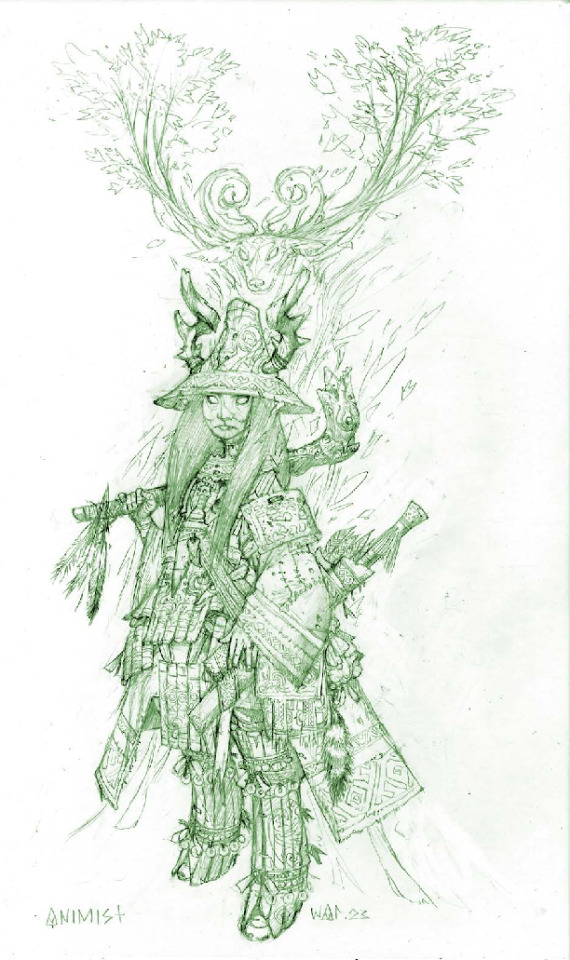
"Samo of Icemark is a middle-aged Varki woman from the Lands of the Linnorm Kings, in the northernmost reaches of the Inner Sea region. Samo is a nephilim, a mortal being with a touch of the celestial planes in her bloodline. Born with the ability to see spirits and other entities that others could not, Samo was selected to learn from the elders of Seer’s Home at a young age after her abilities helped her save her village from a kushtaka incursion. Trained in the arts of animism, Samo was proclaimed a sage after successfully bonding with her grandmother’s spirit, an apparition known as a custodian of groves and gardens. Samo served the Varki people for nearly forty years, until the day a young, injured Okaiyan man washed onto shore near Icemark and changed the course of her life forevermore."
"a Wisdom-based divine spellcasting class that bonds with apparitions, ephemeral spirits who share their power and knowledge with the animist in exchange for the animist acting as their agent with the physical world. Bond with a Steward of Stone and Fire to add primal power to your spellcasting, make a pact with an Impostor in Hidden Places to gain access to sneaky and deceptive magics, or allow a Witness to Ancient Battles possess you and lend its martial talents to your repertoire!"
From a brief skim over the Playtest document, it seems like the Animist is sort of a successor to the Shaman and Medium from PF1, communing with spirits and even allowing them to inhabit the Animist's body. Some of the Animist's feats have the "Wandering" trait, which was something in PF1 that allowed the Shaman to choose new spirits each day. They have spells that they both prepare and spontaneously cast, which... seems interesting? I'll have to see how that plays to work out if I like it or not. They also have focus spells, which are kind of a given for spellcasters in PF2, but juggling three different resource pools seems like a lot for a spellcaster. The Shaman in PF1 was one of my favourite classes so I'm looking forward to giving the Animist a go, although I am unfortunately the ForeverGM so I don't get very many opportunities to build and play characters.
I wonder if they chose the name "Animist" just to make it clear that it's not the same class as in PF1, or if they're choosing to avoid the word "Shaman" because of specific, real-world uses of the word. I've written before that Paizo is very aware of, and trying to avoid, cultural appropriation. They've changed game terms in the past (such as "phylactery" and "totem") to avoid negative associations with real-world religious or cultural things, or otherwise perpetuating reductive stereotypes. I dunno, maybe I'm thinking too much about it. Though the term shaman does originate from Tungusic, the practice of shamanism isn't unique to that region of the world.
Exemplar
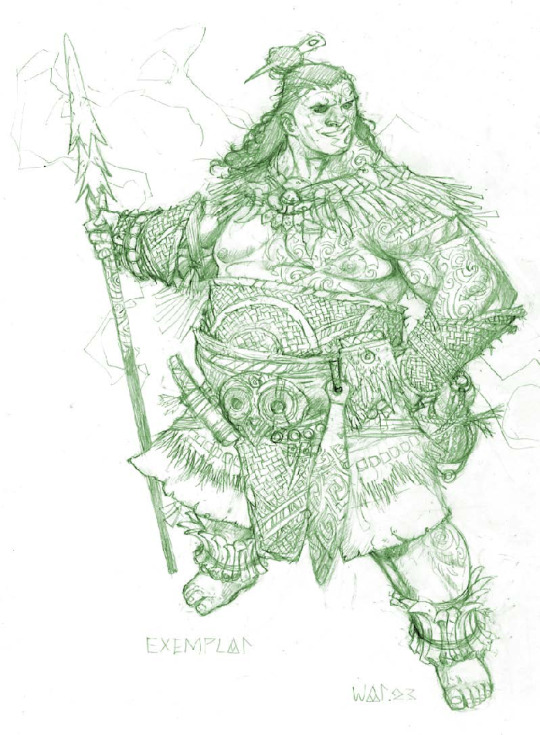
"Nahoa is a young human man of the Olehala people, one of the four great voyaging nations of the Okaiyo Ocean that spans Tian Xia and Arcadia. Born on the rainy side of his island, Nahoa grew up digging canals for his family’s taro farm, taking care of his younger sisters, and ensuring his village never lost the yearly stone-hurling championship. Though he wanted nothing more than an easy life, Nahoa was Called to exchange his digging stick for a warrior’s spear when a great demon returned, as it had for decades, to prey on his home. He faced the beast high in the sky, and even as his spear pierced it, its talons dug into his flesh. Rather than succumb to the creature’s venom, Nahoa claimed its power as his own, becoming a nephilim in the process. He crashed, far from the Okaiyo, where he would meet a Varki woman and set off on a quest across a distant Inner Sea."
This is Pathfinder's very first rare class. That means, guidance given, it won't be available for most tables to play. I can see why they chose to do that, since while it doesn't seem to be overpowered, it is thematically very different to most other classes, and having only one Exemplar in a party might lead that player to believe themself to be the "Main character"
"a Charisma-based divine warrior possessing their own spark of divinity. The exemplar can move their divine spark between receptacles called ikons to unlock potent effects and abilities. As your power grows, you create your own epithet that defines your immortal legacy; whether you become a Cunning exemplar who’s Restless as the Tides and known to be a Thief of Moonlight, or a Brave exemplar, who’s Peerless Under Heaven and destined to be The Last Ruler of an ancient kingdom, is up to you!"
The examples given are Herakles, Cú Chulainn and Maui, so the speculation wasn't far off.

The Exemplar seems to have a lot of moving parts. They have a number of "Ikons" which they can turn on or off in combat. One Ikon can be active at any time, and the Exemplar can activate different abilities depending on which Ikon is on.
Most of the weapon-focussed classes in this game have a feature where they deal extra damage with their weapons as they gain levels. In the case of the Exemplar, it's spirit damage, and they can later become Holy or Unholy, meaning their spirit damage is more potent against creatures of the opposite alignment.
They also get to choose an epithet that expands as they gain levels, starting with something as simple as "The Brave" but ending with something as badass as "Peerless Under Heaven". Many of the Exemplar's feats are about pushing themselves to greater feats of strength, superhuman athletics and acrobatics and stuff like that.
I'm reminded of the Epic Destinies from Dungeons & Dragons 4th edition, which inspired the Mythic Paths in Pathfinder 1e (and was possibly inspired by the BECMI "Immortals" set or another expansion from an earlier edition). To be honest, having played a bunch of Wrath of the Righteous recently, I am pretty hyped to have something adjacent to Mythic tier in this game. I guess we'll have to wait and see if it's just the Exemplar or if those concepts are expanded to other characters as well.
Edited to Add: Uh yeah it looks like we're getting Mythic character options in this book. I didn't read the preamble for the playtest but:
"The animist and exemplar will appear in the upcoming sourcebook Pathfinder War of Immortals, scheduled for Winter 2024, which also brings new legendary creatures and character options for a wide variety of classes and characters, as well as bringing new mythic rules to Pathfinder!"
(emphasis mine)
So yeah. I get hyped about every Pathfinder sourcebook release. Always have. Unfortunately, my group has to deal with rapid and dramatic genre shifts when something new comes out and I pivot our existing campaign to adopt those subsystems. Some day I will use all of the subsystems in the same game.
44 notes
·
View notes
Text
Umay

is the goddess of fertility in Turkic mythology and Tengrism, and hence associated with women, mothers, and children. Umay not only protects and teaches infants, but it may also separate the souls of the deceased, particularly small children. She resides in heaven and is unseen to the average person. The souls of unborn newborns are housed in her "temple" on Mount Ymay-tas or Amay. The Khakas highlight her in particular. The essence of fire (Od Ana) originated in Umai.
In the 8th century inscription of Kul Tigin, the name appears in the phrase Umay teg ögüm katun kutıŋa "under the auspices of my mother who is like the goddess Umay".
Umay is the guardian of women and children. The oldest evidence is found in Orkhon writing monuments. From this, it is clear that Umay was recognised as a mother and mentor. Additionally, khagans were considered to symbolise Kök Tengri. Khagan spouses, known as katuns or hatuns, were also considered Umays. Katuns had offspring with the aid of 'Umay, and these infants served as the empire's guarantee. According to Divanü Lügat'it-Türk, when women worship Umay, they bear male children. Turkic women use strings linked to miniature cradles to will a baby from Umay. This idea is shared by the Tungusic peoples of southern Siberia and the Altai people. Umay is always pictured with a child. There are very few exceptions to this.It is thought that when Umay leaves a kid for an extended period of time, the child becomes unwell, and shamans are summoned to bring Umay back. A sleeping baby's smile indicates Umay's presence, while wailing indicates Umay's departure.
According to Potapov, Umai, as the guardian of newborns, transports deceased children to paradise. According to the Kyrgyz people, Umay protects not just children but also Turkic communities worldwide. At the same time, Umay helps people gain more food and products while also bringing them luck.
Umay is known as Sarı Kız, or 'Yellow Maiden', because to her association with the sun. Her colour and emblem are yellow. She is pictured with sixty golden tresses that resemble sun beams. She is considered to have formerly been identical to Od iyesi. In the Republic of Turkey, female given names include Umay and Ece.

11 notes
·
View notes
Text
Sakha
In this post, where I use "Sakha" and "Yakutia", they are interchangeable
If you just want headcanons, it's right at the bottom of this post
Name: Erchim Basygasov
The reason why I gave him this name:
Erchim, in the Sakha language means vigorous/active/energetic. I think it suits him well as I see him as being quite outgoing/a busy body.
Basygasov: I know it seems like I gave him a Russian last name but there is a reason behind this. Many common Sakha surnames are either Russian in origin or are modelled after Russian names. I chose to go with the "Sakha name that was modelled to sound like a Russian name" route. The nickname "Bahygas" comes from the adjective meaning "able to draw" in Sakha, and so this Sakha nickname is then modified to sound like "Basygasov" as a surname. I chose this surname because I see him as actually being quite artsy!
Origins
His exact birthdate is extremely uncertain as its said that the Sakha people may have settled in the area around the 9th-16th centuries
I'll say that he emerged from 1300-1400 as a distinct group to try and find a balance between those dates.
The ancestor of the Sakha before they migrated Northwards are said to be the Kurykans, who moved from Yenisey River to Lake Baikal in the 7th century, and likely had some level of mixing with Mongolic peoples.
Specifically Sakha's origins were most likely during the great migrations in the 13th century (obviously he existed a little bit before these migrations occurred)
Some of the native inhabitants of the Lena (Evenki, Eveni, Yukagir) assimilated with the migrants (him) from the Lake Baikal region/Southern Siberia who were pressured to move because of the Buryats/pressure from the expanding Mongol Empire (according to Sakha's own legends)
The migrants from Southern Siberia, brought language, oral history, and livestock herding. In fact it is these things which is what suggests that Sakha's origins are due to this migration from the south to the north, especially the horse and cattle breeding which was a Southern economy. Unlike Sakha's reindeer herders neighbours, the Sakha farmed horses and cattle, assimilating Eveni and Evenki (Tungusic) cultures in the process, and we can see this especially through Sakha's shamanic traditions.
It was this mixture of cultures that brought about the Sakha people. I actually think Sakha first represented these migrant groups from Lake Baikal as a child and formed his stronger identity as he migrated and assimilated other groups.
This is because the Sakha people greatly tie their origins to these migrations, and as mentioned before, according to their own legends, they were "driven out" by the Buryats/expansion of the Mongol Empire to move Northwards, centring the origins of their history to these migrants and the migration.
These migrants are speculated to be of Turkic/Turko-Mongol origin. Possibly even Khakas to an extent
Mfw Sakha sounds like Khakas 🤒
But in all seriousness, the origin of the ethnonym Sakha was seen as linked to the Sagay Khakas of Abakan River however this cannot be seen as certain
So Sakha settled in areas with grazing along the Lena, Vilyuy, and Aldan rivers. Again this differed from the smaller, original populations like Even, Evenk, and Yukagir (reindeer herders), who either assimilated or relocated to uplands due to their hunting and reindeer herding economies.
So... Sakha 🤝 Chukotka when it comes to assimilating people
Sakha oral epics mention leaders like Tygyn, the most powerful among them, who formed a chiefdom in the 17th century by subjugating other clans.
So in the late 16th to early 17th centuries, Kangalastsy tribe, led by Tygyn was the most powerful and respected.
They lived in the central steppe area of the Middle Lena valleys, enabling them to excel in cattle farming and gain economic and military advantages.
The Kangalastsy were significant in shaping the Sakha culture, and it's somewhat speculated that they are linked to an ancient tribal union called kangly, which opposed the Hunnic State in the Syr Darya region centuries before (cannot be certain).
According to Sakha folklore, Tygyn was a descendant of Badzhei.
He was the son of Munn'an Darkhan and the grandson of Tyusyulge Darkhaan. Tygyn was notably tall and became the Chief King after his father.
And again, he united various Sakha clans.
So he was kind of like... The Sakha version of Genghis Khan?
However, in 1628, Tygyn's forces were defeated by the advancing Russians, armed with firearms. He was captured and imprisoned, where he suffered from a skin condition and passed away in 1632.
In that same hear, the Yakutsk fort was built, forming Yakutia's link to Russia.
However this was not at all peaceful. The Sakha rebelled seven times (1633-1684) and was met met with harsh suppression.
But before this, Tygyn did manage to be a pain in the arse for the Russian Cossacks - it is mentioned that in 1631 they could not collected fur tax from him
Further: In Legends, Russian Cossacks met Tygyn and praised the power of the Moscow Tsar. They asked Tygyn and the Sakha people to submit, promising mercy, wealth, and rewards. However, Tygyn declined, challenging the Cossacks to a fight instead.
In 1634, Cossack chief Ivan Galkin noted that Kangalas princes (Tygyn's sons/descendants?) controlled vast land and people, even other princes.
They avoided paying taxes for a while. But by 1637, Tygyn's sons submitted, paid taxes, gave hostages, and showed loyalty. Many Sakha people followed, making the Sakha territory part of Russia.
The fact that a majority of the other Sakha people submitted along with Tygyn's sons goes to show how influential Tygyn's lineage was/links to what I said previously about how influential they were in shaping Sakha culture
In the next year, 1638, the Yakutsk district was created, becoming Yakutsk province in 1775, and later Yakutsk region in 1784
So....Sakha was essentially on a pretty strong grind before Russia came along. Tygyn put up a good resistance but his sons on the other hand... 🤒 He malds about it but he also knows it was kind of inevitable
Still kind of glorifies Tygyn to this day
Before Russian colonisation, Sakha was pretty enthusiastic/strong willed. His strong willed nature still followed him however the enthusiasm waned a little under Russian colonisation. A large part of his early enthusiasm can be chalked up to his new found wealth and strong leader, so it was a pretty drastic change of mood once it was abruptly ended by the colonisation period. He didn't take it too well because it was, well, unexpected. He (rightfully) held on to a lot of anger/resentment for a while.
I've mentioned other people who he had contact/relations with such as the Even, Evenk and the Yukagir. Major parts of Sakha culture were derived from these peoples. I see those three as almost being his mentors in a way because of this. On one hand, they were annoyed at this kid who suddenly moved there out of seemingly nowhere which is now forcing them to move more North >:( but on the other hand it was also "Well... He's here so we might as well try and teach him some things if he wants to survive 🙄". I see Evenkia as being his main kind of mentor as Evenki culture influenced Sakha culture more majorly.
On average, Sakha has a good relationship with all of them (especially when they ask him for advice on legal troubles.)
To be fair though, Yukagir is probably the most annoyed by Sakha (when she does feel in the mood to be annoyed at someone) because mass-assimilation affected her the most.
Life under Russian colonisation
In the 17th century, Sakha people fought fiercely against Russian control until 1642. Then, Russian missionaries tried to convert the Sakha to Christianity between 1651 and 1700.
During the 18th century, the Sakha had to move due to political and environmental reasons. Russians took advantage, taking control of Sakha areas.
By 1773, the Imperial mail system reached the Sakha regions. Political opponents of the Tsarist regime were put in prison camps. In the 19th century, Yakuts switched to sedentary farming and Orthodox Christianity.
In 1846, gold discovery led to Russian immigration, changing the demographic of the population.
In the early 20th century, Yakuts were involved in the Russian Civil War, supporting both Red and White armies. In the aftermath of World War I, the Russian Revolution, and the Civil War, the Soviet government established the Yakut Autonomous Soviet Socialist Republic in 1922.
While Sakha was somewhat... Appreciative of this move, it still wasn't enough. By appreciative I don't mean he kissed Russia's ass on got on his knees thanking him, absolutely not. More like, he saw it as a push in the right direction in general.
Sakha is always one to push things to get his way, and though some things from the Russians were inevitably accepted such as orthodox Christianity and sedentary farming - this is not a testament to Sakha keeling over easily. As I will talk about in my next bullet points, Sakha played a prominent role in not only protecting his own interests, but other Siberian interests too.
This is why earlier I talked about the likes of Even, Evenk and Yukagir asking him for help with certain legal troubles. I think Sakha has always been quite outgoing and you can see this even before Russian colonisation. So this skill of his stuck through, which is why he's such a prominent player in these types of affairs but also very keen on getting himself out there, as seen later under my "Business brained?!" subheading of this post.
Collectivisation and sovereignty
From 1925 to 1960, Sakha agriculture was collectivised, leading to resistance and subsequent repression.
Sakha organisations, schools, and publications were banned, and Stalin's industrialisation policies led to significant Russian immigration into Sakha .
Throughout this period, Yakuts fiercely clung to their language, which became a symbol of resistance under Soviet rule. It was one of the only ways in which they could resist
In the late 20th century, amid Gorbachev's reform policies, Sakha nationalism resurfaced.
In March 1990, an Association of Peoples of the North was formed, with Sakha playing a prominent role.
This association aimed to protect the interests of 26 ethnic groups, including the Sakha, and increase their bargaining power in economic and political negotiations with Moscow.
In August 1990, Yakutia increased its autonomy within Russia by issuing a declaration of sovereignty
Sakha proclaimed its sovereignty within the Russian Federation in September 1990, adopting the formal name Yakut-Sakha Soviet Socialist Republic, aligning with the traditional name of the Sakha people.
In August 1991, Sakha's parliament passed a law, transferring control of all state enterprises from the USSR central government to the republican authority.
By December of the same year, Mikhail Nikolayev secures a resounding victory, becoming Sakha's first president with over 70 percent of the vote
Further push for greater Sovereignty
In January 1992, Sakha parliament aimed for more independence, proposing a treaty with Moscow. The treaty would give Sakha control over precious metal reserves for global sales. But this sparked criticism from local Russian legislators, calling it secessionist.
In May 1992, a new constitution established Yakut-Sakha, declaring local natural resources as owned by the people.
During this time, the Sakha parliament accused the Russian Central Bank of withholding funds, causing economic issues. This led to worker payment problems and threats of strikes, risking disruptions in diamond, gold, coal, and other exports.
...Sakha is definitely not afraid to speak his mind and outright call Russia out on his bad behaviour, but this goes for anyone who behaves badly in general too. He cares little for sparing peoples feelings when his interests are being obstructed - especially if it's Russia doing so. This doesn't mean that he's not open to working with Russia, just that he places importance on emphasising his own interests. If it doesn't benefit him somehow in some way, he doesn't want to deal with it.
This attitude is reflected in a point I make later on in this post, which talks about an incident that took place in December 1997 in which the Sakha Republic refused an agreement with the Russian defense ministry.
Business brained?!
This may seem like a random subheading but I have talked about the contents of this previously so hear me out.
In June 1992 Sakha's President Nikolayev visited Latvia for economic ties.
Then, in August of the same year, Presidents of Sakha, Tatarstan, and Bashkortostan warn Moscow about regional sovereignty plans.
In February the following year, Sakha and Irkutsk Oblast sign an economic cooperation agreement.
In May 1993, Sakha and Mongolia agree on cooperation in science, culture, and trade.
The next month, Sakha and Kazakhstan sign a five-year economic cooperation pact.
In January the following year (1994) Sakha and Ukraine agree on a five-year economic cooperation deal.
Sakha was very eager to #grind and get himself out there after being declared the Republic of Sakha in late December 1991. As I said before, Sakha has always been quite goals driven even before Russian colonisation, so it's not really a surprise that he did this.
I see him as being a big organiser of events between the Siberian peoples and is always one to lend an ear out/a helping hand out if someone is in need of some assistance.
Examples of him not taking shit but also being business brained™:
In March 1997, Sakha opposed a military rocket launch from Svobondy Space Center due to safety concerns. The government doubted the environmental impact and technical safety of the rocket. Despite objections, the Ministry launched the rocket, and its second stage fell near a Sakha village.
This incident led to a lawsuit against the Military Space Force, causing Sakha to cancel its 1996 agreement.
In October 1997, Yakutia's Parliament members expressed concern to national deputies about insufficient support for the Far North residents in the upcoming winter. They stated that 80% of Sakha's resources come from outside the republic, but government support for these deliveries had drastically reduced to 20%.
The deputies argued that the proposed 1998 federal budget lacked a separate allocation for delivering products to the Far North, leaving the state neglecting its responsibility to support this region.
In December 1997, Sakha's government refused an agreement with the Russian Defence Ministry for using its territory as a rocket dumping ground due to lack of examination and compensation. The agreement was later signed after agreeing to share revenue from commercial launches.
In July 1998, Sakha passed a law allowing various entities, including foreign citizens and legal entities, to use mineral deposits if registered in the republic and authorised by Russian and Sakha laws.
What's important is that the law also banned using these resources for nuclear weapons, mass destruction weapons, and radioactive substance burial.
Sakha isn't necessarily 100% against working with/co-operating with Russia of course as it does have it's benefits and it's not his goal in life to just purposefully antagonise. However his more outspoken nature and willingness to bluntly point things out has given him a bit of a reputation - despite him actually being quite co-operative/amicable for the most part. He's willing to co-operate, but not to bend over and shut himself up if he disagrees with something.
Quick sidenote on the Dolgan: I see Sakha as being quite close with Dolgan. Dolgan culture incorporates aspects from different groups, including reindeer herding from the Evenki, herd dogs from the Nentsy, and women's fur coats from the Sakha.
In fact, the Dolgan people originated from a few Evenk clans that later adopted a dialect of the Turkic-speaking Sakha (Yakut).
So Sakha does try to look out for Dolgan and imagining him like. Dressing her up/giving her clothes and jewellery is so cutee. He's a lot more involved with her than Evenkia is, much to his annoyance.
Headcanons summarised and some more headcanons:
He is actually quite interested in art! There's the National Art Museum in Sakha which I think he likes to go to to unwind
It's also the largest Art Museum in North East Siberia
Is quite good at drawing himself and is quite crafty. Doodles often when he's bored during a meeting
Big organiser of get togethers/events
Quite outgoing/approachable
Smoker 🤒
Saul Goodman of Siberia I guess
Proud father™ to Dolgan😍
Considers Evenk, Even and Yukagir his mentors however acknowledges that Evenk was the major one, even if he slightly annoys him these days
Sakha produces 1/4 of the world's diamonds yet little of that wealth has tricked down to him. Which is something he malds about
Unfortunately diamond mining has disproportionately affected Sakha's neighbours. That being, the Even, Evenk, Yukagir and Chukchi.
He does feel guilty about this, especially considering how 3/4 of them were his former mentors. This is a point of tension in their relationship
Lowkey intimidated by Chukchi/Chukotka..
His life isn't consumed with hating Russia 24/7 however he'll never truly care for Russia or like/love him. He tolerates him most days and that is probably the most positive feeling he'll be able to feel for Russia (this can be said for a lot of the other Siberians to be honest)
Sure, he likes when Russia is co-operative and he benefits from it but that's not him liking Russia himself
Funny relationship with Buryatia/Mongolia like wow a huge part of my identity was formed because of you guys pushing me out.
Some... Not so healthy coping mechanisms but he's gucci for the most part
Debate club vibes
Russia can be quite chauvinistic at times and tries to paint himself as some sort of mentor to Sakha. As you can guess Sakha despises when he does this and reminds him who he actually considers his mentors
"I'd let Evenkia leave me with another baby again before -"
Lowkey tries to be sort of a big brother to other Siberians despite being younger than quite a few of them
This sort of irks the older Siberians at times
Was baptised at some point in the 18th century and was given a Russian name that he went by for a period of time (only in front of Russia tbh). Has since dropped the Russian name completely.
Gets extremely agitated when Russia calls him his former Russian name
Workaholic 👎 but is always willing to lend a hand with helping someone if they really need him
Good legal advice 👍
Has his own little art projects that he barely has time to finish. A lot of which is just making cute jewellery for Dolgan -
Diplomacypilled™ unfortunately
#Aph Sakha#Hws Sakha#Hetalia Sakha#Aph even#Hws even#Aph evenia#Hws evenia#Hetalia even#Hetalia evenia#Aph Evenk#Hws Evenk#Hetalia Evenk#Hws evenkia#Hetalia Evenkia#Hws Dolgan#Hetalia Dolgan#Aph Russia#Hws Russia#Hetalia Russia#Aph Yukagir#Hws Yukagir#Hetalia Yukagir#hetalia world series#Hetalia world stars#Hetalia oc#Hetalia Siberia#Hws Buryatia#Aph Buryatia#Hws Yakutia#Aph Yakutia
24 notes
·
View notes
Text

The earliest known depiction of a Siberian shaman, produced by the Dutch explorer Nicolaes Witsen, who authored an account of his travels among Samoyedic- and Tungusic-speaking peoples in 1692. Witsen labelled the illustration as a "Priest of the Devil" and gave this figure clawed feet to highlight his demonic qualities
3 notes
·
View notes